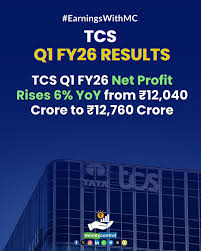
When Tata Consultancy Services (TCS), India’s largest IT services company, announces its quarterly earnings, the entire market listens. On July 10, 2025, TCS released its Q1 FY26 financial results, showcasing steady profits despite global economic pressures. In this post, we’ll break down the numbers, analyze what’s driving the results, and explain what this means for investors, employees, and the broader IT industry.
TCS Q1 Result FY26: Financial Highlights and Growth Drivers:
Let’s start with the key figures that made headlines:
| Metric | Q1 FY26 | YoY Change |
|---|---|---|
| Revenue | ₹63,437 crore | +1.3% |
| Profit After Tax (PAT) | ₹12,760 crore | +6% |
| Operating Margin | 24.5% | +30 bps |
| Order Book | US$9.4 billion | – |
Though the revenue growth appears modest, the 6% growth in net profit paints a picture of resilience in a cautious global environment.
Why Revenue Growth Slowed in Q1 FY26:
While TCS maintained profitability, revenue growth was sluggish compared to previous quarters. The reasons are quite clear:
- Global Macroeconomic Slowdown: Many clients, especially in North America and Europe, have been cautious with IT spending due to inflationary pressures and geopolitical tensions.
- Delayed Client Decisions: Enterprises are taking longer to approve large IT deals, resulting in slower deal ramp-ups.
- Currency Headwinds: Constant currency revenue actually declined by 3.1%, marking the first such drop since FY21.
Despite this, TCS still outperformed some expectations, thanks to its diversified client base and strong digital offerings.
How Did TCS Maintain Profitability?
Here’s where TCS impressed analysts and investors alike.
Cost Control: The company demonstrated excellent operational discipline, keeping expenses in check.
Delayed Salary Hikes: TCS delayed employee wage hikes this quarter, which directly supported margins.
Higher Non-Operating Income: Gains from investments and forex benefits further boosted profits.
AI & Automation Focus: Investment in AI-led solutions improved delivery efficiencies.
TCS also maintained its robust cash flow, with free cash flow conversion at a remarkable 100% of net income this quarter.
Sector-Wise Performance
Here’s a brief look at how different business verticals fared during Q1 FY26:
| Vertical | Growth (YoY) |
|---|---|
| BFSI (Banking & Finance) | +1% |
| Technology & Services | +1.8% |
| Retail & CPG | Decline |
| Manufacturing | Decline |
The BFSI segment, which contributes over 30% of TCS’s revenue, showed moderate growth despite challenges. However, discretionary spending in retail and manufacturing remained muted.

AI & Digital Push: The New Growth Engine
One of the standout themes from TCS’s Q1 results is its strong focus on Artificial Intelligence (AI) and cloud technologies. According to the COO, TCS has doubled down on AI-powered solutions, investing in:
- AI Infrastructure & Platforms
- Advanced Data Analytics
- AI Agents for Automation
- Business-Centric AI Applications
TCS reported over 15 million learning hours dedicated to AI and cloud technologies this quarter, with more than 114,000 employees trained in these advanced skills.
Employee Metrics: Hiring Slows, Focus Shifts to Productivity
TCS’s total headcount stood at 601,546 as of Q1 FY26. However, net employee addition slowed compared to previous years. This reflects the industry-wide trend where IT firms are focusing on productivity gains over aggressive hiring.
Attrition also declined significantly to below 15%, indicating better employee retention amidst cautious hiring.
Source: Economic Times
Dividend & Returns to Shareholders
TCS declared an interim dividend of ₹11 per share, maintaining its commitment to rewarding long-term investors. The record date is July 16, 2025, with payouts scheduled for August 4, 2025.
What Does This Mean for TCS Investors?
For investors, TCS’s Q1 FY26 results signal a mixed bag:
- Positives: Strong profitability, dividend payouts, stable margins, and proactive AI strategy.
- Concerns: Sluggish revenue growth, soft order book, and cautious client spending.
However, TCS’s management remains optimistic about a recovery in the latter half of the year, driven by digital transformation projects.
Market Reaction
Following the earnings announcement, TCS shares showed mild volatility but remained largely stable. Analysts expect the stock to remain range-bound in the near term but view the long-term outlook as positive due to its strong fundamentals and AI-led positioning.
Key Takeaways from TCS Q1 FY26 Earnings
- Resilient Profits: Net profit rose 6% despite revenue challenges.
AI-Powered Future: Significant investment in AI, automation, and digital services. - Disciplined Cost Management: Stable margins despite headwinds.
- Long-Term Focus: Strong learning culture and talent reskilling initiatives.
Final Thoughts: TCS Steady Amid Uncertainty
While global IT spending faces turbulence, TCS has demonstrated once again why it remains a bellwether for India’s IT sector. The company’s ability to sustain profits, maintain operational excellence, and aggressively pivot toward AI-driven services positions it well for the future.
Investors, clients, and employees alike can find reassurance in TCS’s long-term strategy, even as near-term challenges persist.

